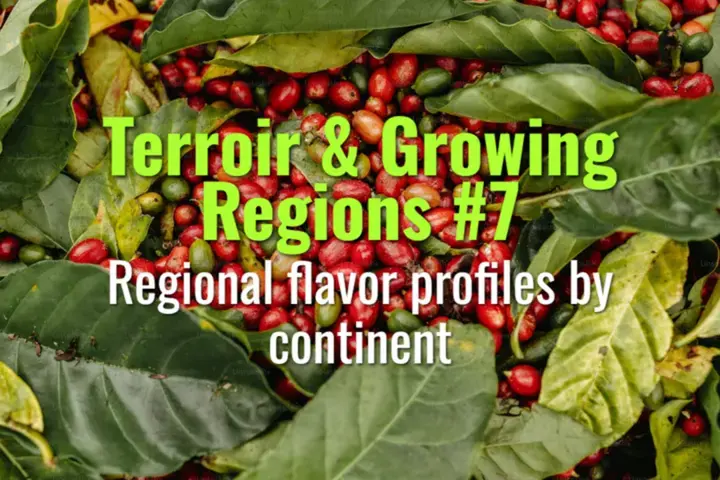Regional flavor profiles by continent
This topic explores the characteristic flavor profiles of coffees from different continents, showing how terroir, cultivars, and processing methods shape sensory identities across regions.
- Coffee Basics Nerds
- 2 min read
Article 7 of 12 in Terroir & Growing Regions/

Africa
- Ethiopia: Birthplace of Arabica; diverse heirloom varieties. Flavor: floral, tea-like, citrus, stone fruit. Processing: washed and natural.
- Kenya: Known for SL28/SL34. Flavor: blackcurrant, berry, bright citrus acidity, winey notes. Processing: washed.
- Tanzania: Often peaberries. Flavor: bright acidity, medium body, fruity.
Latin America
- Brazil: World’s largest producer. Flavor: chocolate, nutty, low acidity, heavy body. Processing: natural and pulped natural.
- Colombia: Balanced profiles with caramel sweetness, medium acidity, versatile cup. Processing: washed.
- Central America (Guatemala, Costa Rica, Honduras, El Salvador): High-altitude Arabicas with bright acidity, sweetness, and complexity. Flavors range from citrus and floral to cocoa.
- Mexico: Mild, nutty, sweet, light-bodied coffees.
Asia-Pacific
- Indonesia (Sumatra, Java, Sulawesi): Distinct wet-hulled processing. Flavor: earthy, spicy, herbal, full body, low acidity.
- Vietnam: Largest Robusta producer. Flavor: strong, bitter, chocolatey, used in espresso blends and instant coffee.
- Papua New Guinea: Unique island terroir. Flavor: fruit-driven, complex, bright acidity, medium body.
Middle East & Arabia
- Yemen: Traditional dry-processed coffees. Flavor: winey, complex, with notes of dried fruit and spice. Rustic cup with historical importance.
Comparative Flavor Traits by Continent
- Africa: Bright acidity, floral and fruity complexity.
- Latin America: Balanced, clean, versatile profiles with medium acidity.
- Asia-Pacific: Earthy, spicy, full-bodied, low acidity.
- Middle East: Winey, exotic, dried-fruit intensity.
Lasting Importance
Regional flavor profiles give coffee its cultural and sensory diversity, allowing consumers to taste geography in the cup. Recognizing these continental signatures helps farmers, roasters, and drinkers connect terroir with identity and appreciate the global tapestry of coffee flavors.
You might also like:
- Tags:
- Lasting Importance
- Latin America
- Acidity Sweetness
- Instant Coffee
- Flavor Profiles
- High Altitude
- Central America
- Bright Acidity
- Middle East
- Heavy Body
- Pulped Natural
- Floral Fruity
- Washed Natural
- El Salvador
- Costa Rica
- Medium Body
- Farmers Roasters
- Low Acidity
- Acidity Floral
- Processed Coffees
- Helps Farmers
- Stone Fruit
- Chocolate Nutty
- Espresso Blends
- Sweetness Complexity
- World Largest